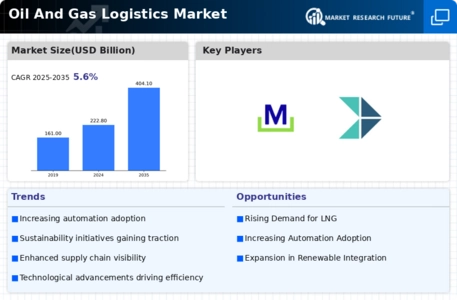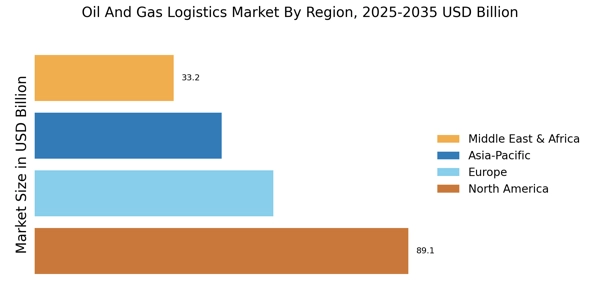Geopolitical Factors
The Oil And Gas Logistics Market is subject to fluctuations driven by geopolitical factors. Political stability in oil-producing regions directly affects supply chains and logistics operations. For instance, tensions in the Middle East can lead to disruptions in oil supply, necessitating agile logistics strategies to mitigate risks. Moreover, trade policies and tariffs can influence logistics costs and routes. As a result, logistics companies must remain vigilant and adaptable to changing geopolitical landscapes. This awareness allows them to develop contingency plans and maintain operational continuity, ensuring that they can meet the demands of the market despite external challenges.
Regulatory Compliance
The Oil And Gas Logistics Market is heavily impacted by stringent regulatory frameworks aimed at ensuring safety and environmental protection. Compliance with these regulations is essential for logistics companies operating in this sector. For instance, regulations concerning emissions and waste management require logistics providers to adopt sustainable practices. Failure to comply can result in hefty fines and operational disruptions. As a result, logistics companies are increasingly investing in compliance training and technology to monitor and report their activities. This focus on regulatory adherence not only mitigates risks but also enhances the reputation of logistics providers in the market.
Increasing Energy Demand
The Oil And Gas Logistics Market is significantly influenced by the rising global energy demand. As economies expand, the need for energy resources, particularly oil and gas, continues to grow. According to recent estimates, global energy consumption is projected to increase by approximately 30% by 2040. This surge in demand necessitates efficient logistics solutions to ensure timely delivery and distribution of resources. Consequently, logistics providers are investing in infrastructure and technology to enhance their capabilities, thereby positioning themselves to meet the anticipated needs of the market. This trend underscores the critical role of logistics in the energy sector.
Infrastructure Development
The Oil And Gas Logistics Market is benefiting from ongoing infrastructure development initiatives. Governments and private entities are investing in transportation networks, including pipelines, roads, and ports, to facilitate the efficient movement of oil and gas. For example, the construction of new pipelines can significantly reduce transportation costs and transit times, thereby enhancing the overall logistics framework. Additionally, improved infrastructure supports the expansion of logistics hubs, which are essential for storage and distribution. This development is crucial as it enables logistics providers to respond more effectively to market demands and enhances the competitiveness of the oil and gas sector.
Technological Advancements
The Oil And Gas Logistics Market is experiencing a surge in technological advancements that enhance operational efficiency. Innovations such as automation, artificial intelligence, and blockchain are streamlining supply chain processes. For instance, the integration of AI in logistics management can optimize route planning and inventory management, potentially reducing costs by up to 20%. Furthermore, the adoption of IoT devices allows for real-time tracking of shipments, which is crucial for maintaining the integrity of sensitive materials. As these technologies continue to evolve, they are likely to reshape the logistics landscape, making it more responsive and adaptive to market demands.


















Leave a Comment